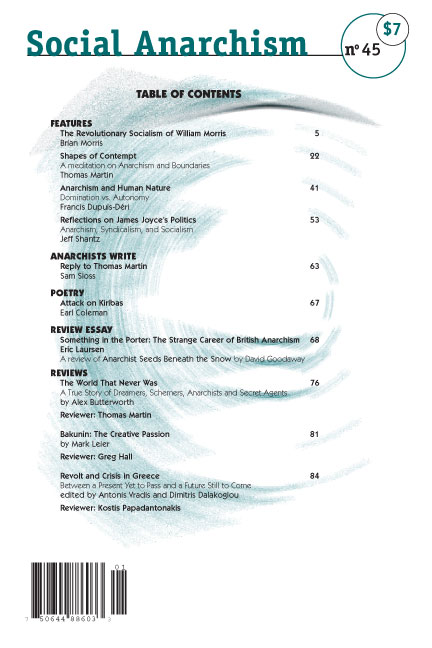Shapes of Contempt
a meditation on anarchism and boundaries
“To rule forever.…it is necessary only to create, among the people one would rule, what we call …Bad History. Nothing will produce Bad History more directly nor brutally, than drawing a Line, in particular a Right Line, the very Shape of Contempt, through the midst of a People, — to create thus a Distinction betwixt ‘em, — ‘tis the first stroke, — All else will follow as if predestin’d, unto War and Devastation.”
Thomas Pynchon, Mason & Dixon (1997)
As anarchists we must disapprove on principle the idea of political boundaries: after all, they define the State in a very concrete fashion, and the State is not a phenomenon of which we are enamored. The concept is however not just limited to nation-states. Boundaries can be very circumscribed, or they can encompass vast regions; the rules governing them can apply to personal space or to empires, and everything between. Achille Varzi points out that if we recognize any boundary, or even part of it, as artificial, then we must accept that whatever it contains is a conceptual construction, something without objective existence. If anarchists do not reject artificial constructs in toto, we must at least reject those that are imposed by authority, and any that are alleged to be immutable.
As with most commonsense ideas, the philosophers have taken ‘boundary’ and parlayed it into something maddeningly inscrutable. Still, we need to look first at some of the philosophical definitions. The ancient Greek mathematicians were the first to take notice of the problem. Euclid described a boundary as “that which is an extremity of anything.” Aristotle was a bit more specific: a boundary marks “the first thing outside of which no part [of the thing] is to be found, and the first thing inside of which every part [of the thing] is to be found.” Unfortunately this does not help much unless we can agree on what a “thing” is. The Greeks established the logical foundation of western thought: the intrinsic dichotomy of subject and object, and this approach has crippled us ever since. Boundaries are a matter of concern throughout the Metaphysics – the world is full of all sorts of phenomena that can be identified and named, but are they all ‘bounded’ in the same way? Does a flame have the same sort of boundary as a rock? What does it mean to say that one entity is ‘separate’ from another? What happens to the boundary when two objects touch one another? Do boundaries have dimension or extension? and so on.
The medieval scholastics, drawing on Aristotle, further confused the issue. Gregory of Rimini, who worked in Paris in the mid-fourteenth century, sensibly defined lines or boundaries as “things divisible only in one dimension.” Leonardo da Vinci wondered whether a boundary is part of the thing it bounds, or just an imaginary construct for the observer’s convenience: what divides the atmosphere from the water? It is necessary that there should be a common boundary which is neither air nor water but is without substance, because a body interposed between two bodies prevents their contact, and this does not happen in water with air. . . . Therefore a surface is the common boundary of two bodies which are not continuous, and does not form part of either one or the other, for if the surface formed part of it, it would have divisible bulk, whereas, however, it is not divisible and nothingness divides these bodies the one from the other.
Descartes also concluded that the boundary is not part of the thing bounded. By the nineteenth century, at the hands of philosophers like Brentano and Frege, the debate had again receded into the more obscure realms of mathematics. In the twentieth, the linguists got hold of it, as did the British common-sense or ordinary-language school. Quantum physics, however, has since introduced a new problem: when subatomic particles flash in and out of existence in nanoseconds, and the atoms composed of them are mostly empty space, where exactly can any boundary or surface be located? We are back where we started, with the boundary as a purely mental construct, existing in our own minds as a convenient way of organizing the world we perceive around us given the limitations of our senses and our instruments. Can there be any objective or ontologically ‘real’ boundaries?[i]
Rumination on this topic is not limited to western philosophy. The Visuddhi Magga (a Theravada Buddhist text) reminds us that merely to name a thing is to assign it boundaries:
A name is imposed on what is thought to be a thing or a state and this divides it from other things and other states. But when you pursue what lies behind the name, you find a greater and greater subtlety that has no divisions. Atoms of dust are not really atoms of dust but are merely called that. In the same way, a world is not a world but is merely called that.
This article is concerned mainly with boundaries that nearly everyone admits are artificial – geopolitical boundaries – which, like the governments they serve, tend to exert a centripetal force on their social and economic contents, pulling everyone and everything towards the center, where power is concentrated. The more exact the boundary, the more easily the power is calibrated. Ecosystems, in contrast, are centrifugal. The contents are pushed out towards the protean and porous boundary, which in consequence opens and closes, shifts and oscillates to accommodate the needs of the system.
Though all cultures recognize political boundaries in some form or another, it was in western civilization that the concept first took on such a dichotomized, dualistic character. This was not always the case: the Romans were on the way towards the precise rectilinear boundary before they were disrupted by the so-called Dark Ages, but they never got there. In the Domesday survey (1086) England’s landscape was described by a wide variety of terms, such as oxgang: the amount of land a plow pulled by one ox can cultivate in a day. No one was much disturbed by questions that would drive the modern surveyor insane: what kind of plow, how strong is the ox, what kind of soil, how long is the day, what’s the weather? Throughout the Middle Ages national boundaries were fluid, depending on the fortunes of war, dynastic marriages, temporary truces and agreements. That all began to change during the late Renaissance, due to a number of factors ranging from printed maps to nostalgia for Roman clarity and exactitude. It is an unfortunate legacy of colonialism that the stark and absolute national boundary pioneered in Europe, and taken to mathematic precision in North America, has now been imposed on the whole planet. We have not yet seen every centimeter of every border surveyed down to a one-dimensional geometric line, but it is not for lack of trying on the part of governments. They understand that precision is power. As matter of course anarchists are opposed to such boundaries on principle, as the ‘containers’ of the State, but many of us may not realize what we’re up against.
A good place to start is etymology. This author is a believer in linguistic relativity, the modern expression of the Sapir-Whorf hypothesis, which suggests that the language we think in affects (to greater or lesser degree) the way we perceive the world. Much of language is really subconscious, and whether or not there is (as Chomsky argues) an underlying common ground for all languages, the genealogy of individual words can provide some insight into connections that may not be apparent to conscious thought.
The English word “boundary” is from medieval Latin bodina, evidently a Gaulish word whose etymology is uncertain. Very likely it comes, like bind, ribbon, bundle, and bandage, from the Indo-European root *bhendh, whose fundamental sense is “bind, tie up, fasten, restrain.” When we look at synonyms we find connotations of separating, restraining, injuring. “Border” comes from *bherdh, meaning “cut.” The word “fence,” related to “defend,” comes from *gwhen, whose original meaning was “strike” or “hurt”; it is also ancestral to “gun.” On the other hand, “limit” is from Latin limes, “threshold,” which may be a borrowing from Etruscan. But “threshold” itself is from IE *ter-, meaning “overcome, break through” (through, trans-). The Romans originally used limes (plural limites) to denote the boundaries between fields. “Frontier” comes from Latin frons, “front” or “forehead,” also evidently not an Indo-European root. Greek used a number of different terms, mostly based on őρος, “mountain” (early Greek city-states were often hemmed in by mountains); the Indo-European root is probably *er/*or, “arise, raise, run, set in motion.” It is interesting to note (though not with absolute certainty) that the ‘violent’ or active words are Indo-European, while the ‘peaceful’ ones are not – the ‘frontier’ invites one to cross it; the ‘boundary’ does not. The Indo-European languages (they used to be called ‘Aryan,’ before the Nazis ruined that word) are the tongues of necrophiliac, world-destroying western civilization.
- [i] The quotations and references in these first paragraphs are borrowed from a superb article by Achille Varzi in the online Stanford Encyclopedia of Philosophy, plato.stanford.edu/entries/boundary/. The quotations are from Euclid’s Elements, Book I, Definitions 1-3, 5-6, 13; Aristotle, Metaphysics 1022a; and Leonardo da Vinci, Notebooks, Edward Maccurdy, ed. (London: Jonathan Cape,1938), 75-76.

